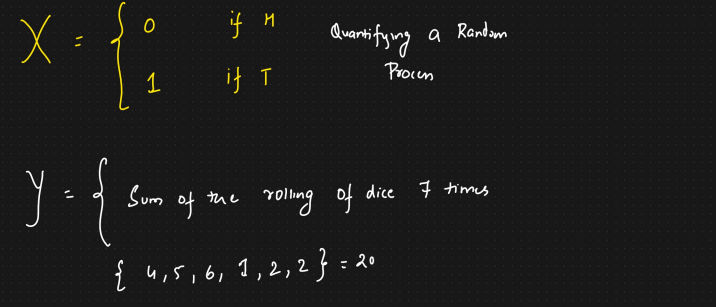1.1 Statistics
Statisticsis the science of collecting, organizing and analyzing the data.- Used for decision making process
Data- facts or pieces of information
1.2 Types of Statistics
- Descriptive stats
- It consists of
organizing and summarizingthe data.
- It consists of
- Inferential stats
- It consists of using data you have measured to
form conclusion,make predictions. - By using sample-data make conclusion on population-data
- It consists of using data you have measured to
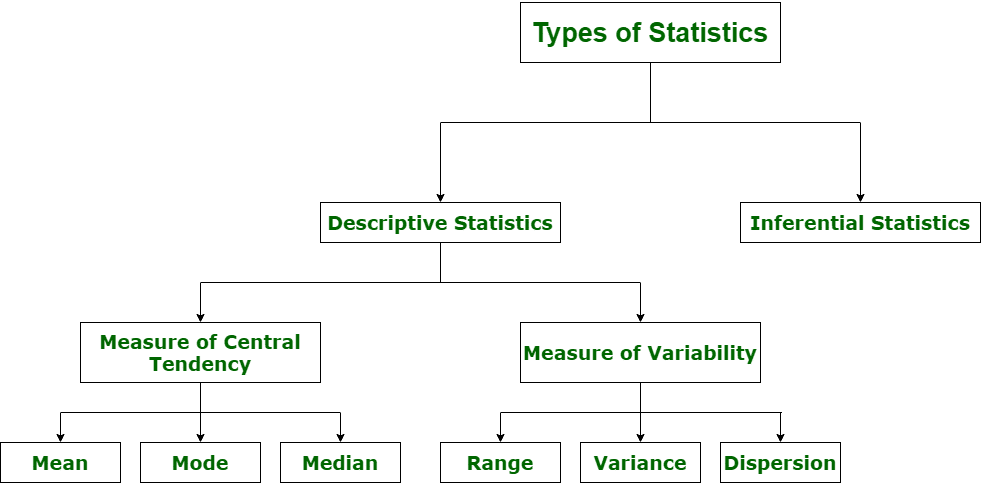
1.2.1 Descriptive stats
- Example
- Average height of the student in a class (Mean)
- Most common height in the class(Mode)
Types
- Measure of Central Tendency
- Mean, Median, Mode
- Measure of Variability
- Range, Variance, Dispersion, Std
- Charts - Data distribution
- Histogram, Bar charts
1.2.2 Inferential stats
- Technique used - to form conclusion
- Z-test
- T-test
- Hypothesis testing, P value
- Example
- Are the avg height of student in the class are similar to what you expect in the entire college
- class -
Sample data, entire college -Population datau
- class -
- Are the avg height of student in the class are similar to what you expect in the entire college
Population vs Sample Data
A population is the entire group that you want to draw conclusions about.
A sample is the specific group that you will collect data from. The size of the sample is always less than the total size of the population.
Why Sample data
Working with sample data is helpful when
- the population is
too large or infinitein size - Size is unknown or
not measurable
This is the preferred method of collecting data when the data you need is too hard to gather.
It’s a way to get information about the population without actually needing to access every person or item in that population.
1.3 Types of Data
* Quantitative Data
* Discrete Data
* Continuous Data
* Qualitative Data
* Nominal Data
* Ordinal Data
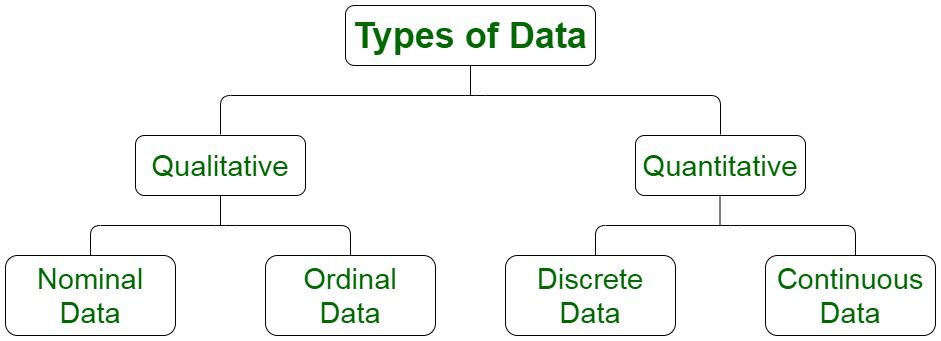
1.3.1 Quantitative/ Numerical Data
- Data is depicted in
numericalterms. - Can be shown in numbers and variables like ratio, percentage, and more.
- Example: 100%, 1:3, 123
Discrete Data
- The type of data that has
clear spaces between valuesis discrete data. - Whole number, Countable
- There are distinct or different values in discrete data.
- Depicted using bar graphs
- Ungrouped frequency distribution of discrete data is performed against a single value.
- Eg: No of bank acount, No of children
Continuous Data
- This information falls into a continuous series.
- Any Value(int, float), Measurable
- Every value within a range is included in continuous data.
- Depicted using histograms
- Grouped distribution of continuous data tabulation frequencies is performed against a value group.
- Eg: Weight, Height, Temperature
1.3.2 Qualitative/ Categorical Data
- Data is depicted in
non-numericalterms. - Could be about the behavioral attributes of a person, or thing.
- Example: loud behavior, fair skin, soft quality, and more.
Nominal Data
- Nominal data attributes
can’t either be ordered or measured
# Examples:
Gender (Women, Men)
Eye color (Blue, Green, Brown)
Hair color (Blonde, Brown, Brunette, Red, etc.)
Marital status (Married, Single)
Religion (Muslim, Hindu, Christian)
Ordinal Data
- Ordinal data is the specific type of data that
follows a natural order.
Examples:
Feedback is recorded in the form of ratings from 1-10.
Education level: elementary school, high school, college.
Economic status: low, medium, and high.
Letter grades: A, B, C, and etc.
1.4 Level of Measurement
- There are four different scales of measurement.
- The data can be defined as being one of the four scales.
Nominal Scale
Ordinal Scale
Interval Scale
Ratio Scale
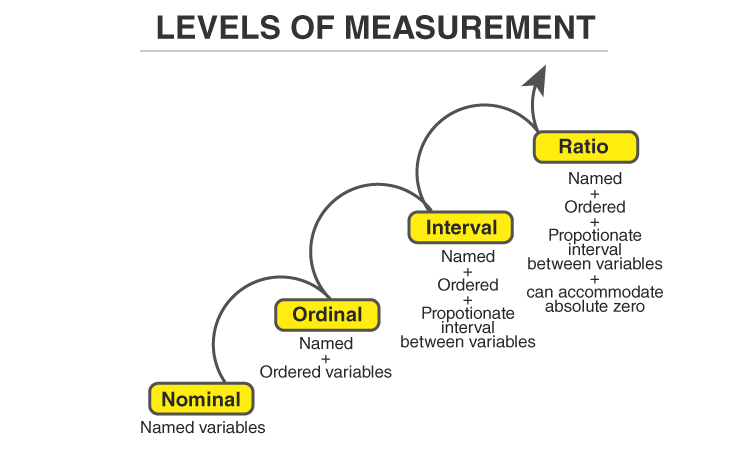
1.4.1 Nominal Scale
- It is the 1st level of measurement scale
- It serve as
tagsorlabelsto classify or identify the objects. Qualitative/Categoricalvariable- Order does-not matter
- Example:
- Gender: M, F
- Color: Red, Blue, Green
1.4.2 Ordinal Scale
- The ordinal scale is the 2nd level of measurement
Orderingand ranking matters- Difference cannot be measured
# Example
Totally agree
Agree
Neutral
Disagree
Totally disagree
# It has ranking and can't calculate difference
1.4.3 Interval Scale
- The interval scale is the 3rd level of measurement scale, which is quantitative.
- Order and Rank matters
- Difference can be measured(excluding ratio)
1.4.4 Ratio Scale
- The ratio scale is the 4th level of measurement scale, which is quantitative
- Order and Rank matters
- Difference and ratio can be measured
1.5 Measure of Central Tendency
- The central tendency is the descriptive summary of a data set
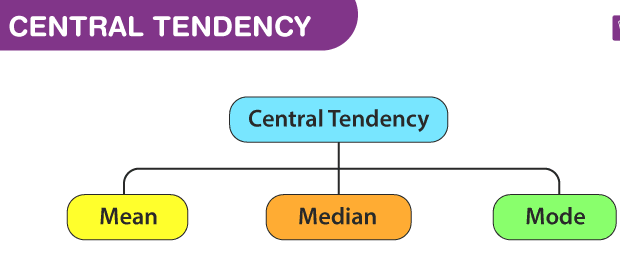
Mean
- The mean represents the average value of the dataset.
- It can be calculated as the sum of all the values in the dataset divided by the number of values.
Population mean (Mu)
Sample Mean (s)

Median
Median is the middle value of the dataset in which the dataset is arranged in the ascending order or in descending order.
When the dataset contains an even number of values, then the median value of the dataset can be found by taking the mean of the middle two values.

Why Median?
- In case on any outlier in the distribution the
- mean - huge affect
- meadian - slight devitaed
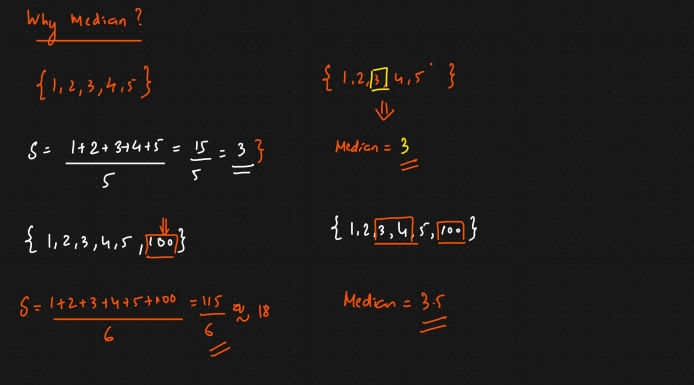
Mode
- The mode represents the
frequently occurring valuein the dataset. - Sometimes the dataset may contain
multiplemodes and in some casesno modeat all.
1.6 Measure of Dispersion
- In statistics, the measures of dispersion help to interpret the
variability of datai.e. to know how much homogenous or heterogeneous the data is. - In simple terms, it shows how
squeezed or scatteredthe variable is.
1.6.1 Variance
- Spread of data
Population Variance (sigma sq)
Sample Variance (s sq)
We use (n-1) rather than n so that the sample variance will be what is
called an unbiased estimator of the population variance - Bessels Correction

Example
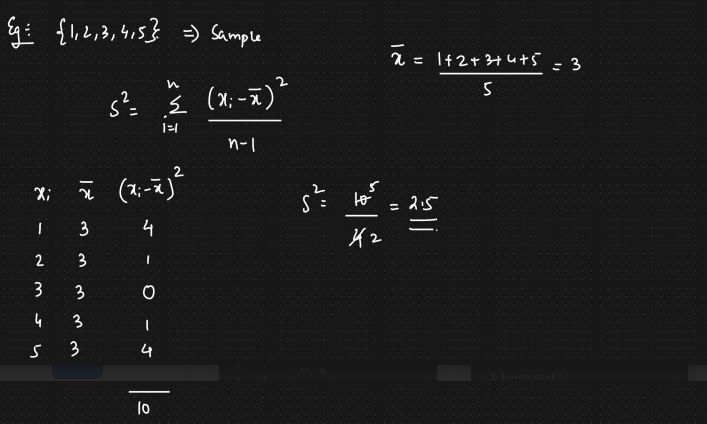
Variance graph
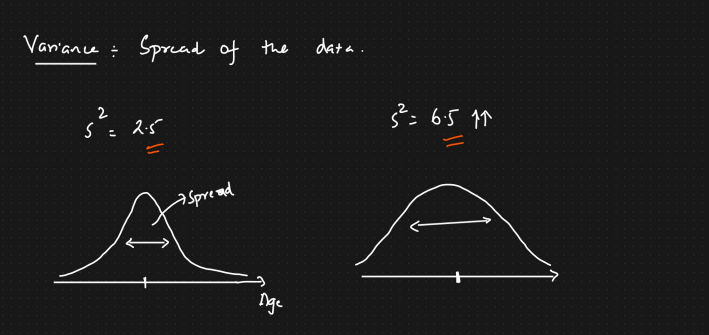
1.6.2 Standard Deviation
Population std (sigma)
Sample std (s)
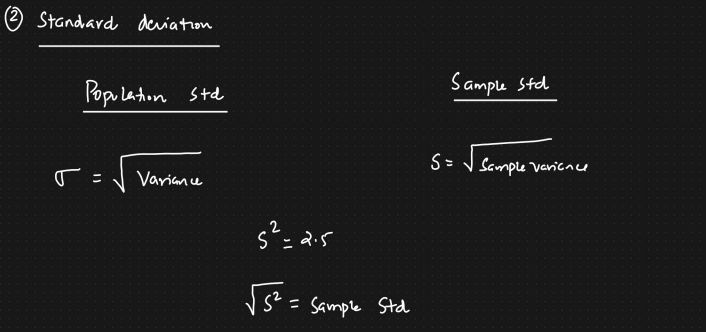
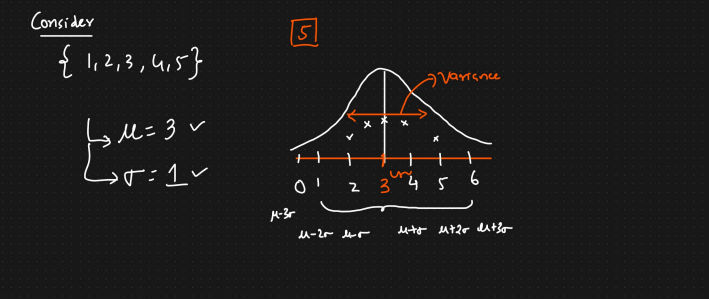
1.6.3 Random Variable
- Random variable is a process of mapping the output of a random process pr expriment to a number
- Eg:
- Tossing a coin
- Roling a dice
Below - Value of x, y if fixed i.e x=2 and y=8
Below - the value of x is not fixed, it depends on the output
